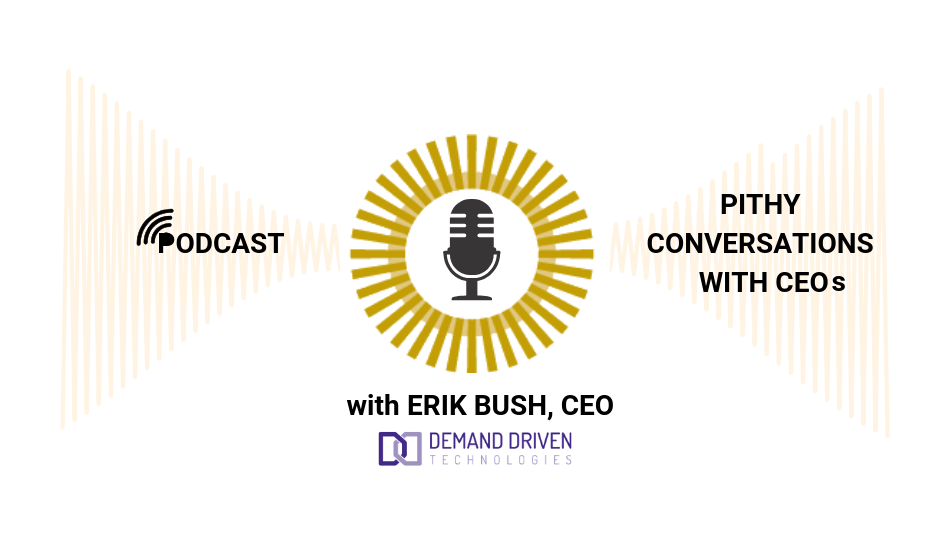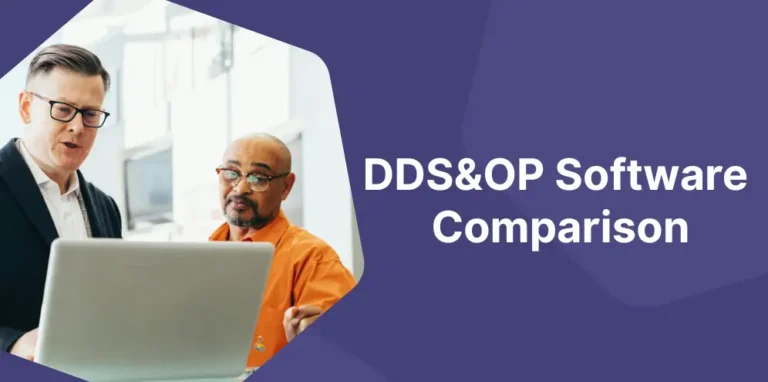In the fourth episode of our podcast series “Pithy Conversations with CEOs,” Trusted Counsel’s Evelyn Ashley and John Monahon speak to Erik Bush, CEO and Founder of Demand Driven Technologies (DD Tech). Founded in 2011, DD Tech specializes in cloud-based supply chain software solutions. With over 80 enterprises, today DD Tech has a global presence and a deep channel partner network.
Audio Transcript
Speaker 1: It is time for “In Process: Conversations about Business in the 21st Century with Evelyn Ashley and John Monahon”, presented by Trusted Counsel, a corporate and intellectual property law firm. For more information, visit trust-counsel.com. And now, with “In Process,” here are Evelyn Ashley and John Monahon.
John: Today we are continuing our series of “Pithy Conversations with CEOs,” and we are fortunate to have Erik Bush from Demand-Driven Technologies here with us.
Evelyn: I think this will be a very interesting chat, John, given that Erik spent lots of his work experience in a very, very large company and decided to go into a startup after retirement.
John: Yes, he’s seen a lot of different environments. So I’m very curious to hear his thoughts on working in a large corporation and then going into a smaller fast-paced company, and his different management styles in each. First, a little bit about Demand Driven Technologies: Demand Driven Technologies was founded in 2011 and specializes in cloud-based supply chain software solutions. With over 80 enterprises, Demand Driven Technologies has a global presence and a broad channel partner network.
Erik, welcome to the show.
Erik: Thank you.
John: I’ve already talked about the company, but I would love to hear about it from you.
Erik: We are a provider of cloud-based supply chain software. We have clients from all around the world, and we have been very fortunate to catch the wave of a new movement called Demand Driven MRP. It was introduced in 2011, and Demand Driven Technologies was the first to adopt that methodology into our Replenishment solution. We have been able to ride the wave that the Demand Driven Institute created by introducing these new concepts to the market field that has not been updated in nearly 40 years.
MRP, or Material Requirements Planning as it’s known, was invented back in the ’70s, back at a time where my former employer, IBM, was introducing computers for use in the manufacturing market place. They believed that with this MRP logic, they could address the needs of manufacturers to plan their inventories and materials in a timely manner. That logic is still in all the ERP systems and has not been changed in 40 years, yet the world we live in has been evolving dramatically.
So, this Demand Driven MRP concept is about pacing our supplies to what’s being consumed in a market, and not being dependent on forecasts. As a result, we are providing our clients with just much, much better results. There was a little anecdote we found along the way with one of our clients, Michelin, who is in the tire business, obviously. If you got back to mid-70s, there were 10 tire sizes in the US market that made up 90% of the sales volume. By 2010, the top 10 sizes only made up 38% of the market.
Evelyn: Wow.
Erik: And there are now 700 sizes available overall.
Evelyn: Wow.
Erik: So if you are trying to operate things in a forecast driven manner, which MRP requires, you can imagine how much easier it would’ve been back in the ’70s than it is now. So clearly the world has changed for all the obvious reasons. This Demand Driven MRP movement has really taken the market by storm. We were the first to adopt the method and have had obviously the largest install base of clients. And probably the big proof in the pudding for us is that it works. Clients get real value out of it and find that they are far less dependent on Excel, which believe it or not many big companies around the world are still using it as their inventory planning tool.
Evelyn: Wow.
Erik: So that was the genesis of the company. We bootstrapped for several years before raising our first venture funding. But we really gained the support of several smaller consulting firms around the world that you mentioned, channel partners who really led the sales effort for us while we were trying to focus on making the technology as viable, modern and SAS-oriented as possible.
John: You had a really long career at IBM.
Erik: Yes.
John: And a very successful career there. Can you tell us what you did there and what inspired you to join Demand Driven Technologies?
Erik: Sure. I was fortunate. I had actually two careers with IBM. I spent three years with the company before leaving to go out and pursue a music career, which obviously didn’t last. Then I was rehired in 1982, but during that time I was in administrative roles, sales, and later moved into the consulting division which was formed in the early ’90s. And from there I rode that tide as it started rising, and the company really developed a large service business.
So it was exciting to be part of a very big, growing entity inside of IBM. At the same time, when we got into the early 2000 decade, you could see that mass was starting to accumulate and become more difficult to grow. Anybody who’s following IBM knows that they’ve really had a challenge over the last several years. But the pros are that you’ve got the resources, you’ve got market recognition, you’ve got scale, all those things are wonderful.
On the other hand, there are a lot of disadvantages to this. As the company grows, it needs to build an organization. You start getting silos, people work in silos, you’re running through management by objectives, so they focus on what they care about. Now you can’t see the big picture and it’s challenging to get the team to work together. I have the deepest respect for all my colleagues at IBM and everything that we were able to accomplish. But at the same time, the scale of itself has some inherent challenges with it.
John: Absolutely. After you retired from IBM, how did you link up with Demand Driven Technologies, and how did you know this was the company you wanted to spend your time with?
Erik: Yes. When I retired, I thought someday I may do something entrepreneurial because I’ve always had that itch to go out and try my luck at that. But it was just kind of a circumstance, a little bit of serendipity. With a consultant that I had hired to work for our organization when I was at IBM, we were implementing some new concepts around the concept called Theory of Constraints. Anybody who has read the book The Goal in Business School would know what I am talking about.
We were applying those concepts internally at IBM. The author of that whole body of work, Dr. Eliyahu Goldratt, was working with us, so I got the great chance to work with him; he was a well-known supply chain thought leader who passed away a few years ago. He introduced me to Chad Smith who was a consultant working in his institute. Chad taught us the concepts that we applied successfully in IBM.
So I retire, and this is 10 years after Chad and I had worked together. Lo and behold, his consulting company had started writing some software, and then realized that they were not going to be well-suited in a technology business; they are more business consultants.
John: Difficult to develop, yes.
Erik: And “Hey, would you think this might be an opportunity?” And this all happened after I retired. I knew the concepts would work because we had applied them successfully inside of IBM. I just got fascinated with what it could bring to the market and the value it could create for clients. And that’s what was the genesis of the company. And yes, it’s been great since then.
John: Yes.
Evelyn: What were your expectations, going into it? Did you have any of what you’d be doing specifically? Or what it was going to be like?
Erik: I knew it was going to be much like a green field. Yes, we had some software assets. There was one gentleman who’d been kind of a customer support person, and he was the only guy that we had left at CMG, Constraints Management Group, my co-founders. He and I started, then one of their consultants joined the team, and that was the beginning of the Demand Driven Technologies.
As you can imagine, you are doing virtually everything. Writing product specs, testing, selling, implementing, learning what this is all about. While I’d spent a lot of time with manufacturers and distributors in my IBM career, I was never this close to the action. I was learning a lot and didn’t really have any clear expectations. But, I knew it would work, and it was so intriguing to see if we could get it to go and make it commercially viable.
I talked to some venture funds at the time, who were very polite and said, “This is all very interesting, Erik…”
[fusion_button link=”https://demanddriventech.com/request-a-demo/” text_transform=”” title=”” target=”_blank” link_attributes=”” alignment=”center” modal=”” hide_on_mobile=”small-visibility,medium-visibility,large-visibility” class=”” id=”” color=”default” button_gradient_top_color=”” button_gradient_bottom_color=”” button_gradient_top_color_hover=”” button_gradient_bottom_color_hover=”” accent_color=”” accent_hover_color=”” type=”” bevel_color=”” border_width=”” size=”xlarge” stretch=”no” shape=”” icon=”” icon_position=”left” icon_divider=”no” animation_type=”” animation_direction=”left” animation_speed=”0.3″ animation_offset=””]Request a Demo of Replenishment+[/fusion_button]
Evelyn: This may be a product, yes.
Erik: … you’re selling into a very sticky area. Supply chain people aren’t going to just jump from one lily pad to the next. So, you’ve got a lot of evangelizing to do.” And they were so accurate about that. But they also said, “We absolutely believe there is an opportunity here, and you are just going to need to stick at it, get to the point where there’s market recognition, and you can build some momentum out there in the market to move it forward.”
Evelyn: So did you have the expectation that you would build it into a company as opposed to building a product?
Erik: Absolutely. They wanted to get out of the software business. This kind of filled my itch to do something entrepreneurial. It was a space I knew. It was built and founded on a lot of the Theory of Constraints principles, so there was a lot ticking the box, I get this.
Evelyn: For interest, engagement, and excitement.
Erik: It was very, very similar to what we had done with using those TOC concepts in IBM. We had called it Replenishment for Resource Management. How to gauge, where to move the consulting organization skills based on actual market usage. Not based on the partner’s forecast, right?
Evelyn: Right.
Erik: So you think about the year of 2000, when we were doing this, right after Y2K ended, we were going into .com. The ERP was exploding, we had way too many skills in the wrong spot and not enough in the right. Obviously, it was a very challenging transition to get through. We had really done a great job migrating our staff from one place to another through these principles. So in my heart, I knew it would work, I knew it was going to be a tough slog, and the VC were absolutely right about the challenges we would face.
John: You did end up raising venture capital though.
Erik: Eventually, yes we did.
John: Yes. You’ve been quite good at that as well
Erik: Once I figured it out.
John: You got quite effective.
Erik: Yes.
John: What was the thought process of going into that?
Erik: After the first forays, we realized it was too early to go out and raise money. We focused on just bootstrapping and taking all of the profits that we could generate from the software and plowing them back into the technology. Because the most important thing we needed to do was to get it to SAS, in the cloud, the modern browser-based application, and a more robust security perimeter and things alike.
Because we set that as our primary goal, we said, “We’re going to sell through the channel partners, that way we don’t have to pay for building a direct sales force,” and that would’ve been a bad move to make. What happened then was that over the ensuing four to five years, we were growing at a good rate, but you could also see that other solution providers were entering the market on this DDMRP. I didn’t want to be the founder who didn’t act quickly enough. Also, as our client base grew, the mountain of their expectations in terms of features and functions that we needed to add, grew with it.
If you’re in the software business, you know you never run out of things to do. We realized that we had to start raising money. So, in early ’17, we raised a small, convertible note round to help prime the pump. We started trying to raise money, ran into some dead ends, didn’t have the messaging right, really didn’t understand well enough investor expectations. And it was just really through a lot of good fortune that we were able to make some connections with people.
And to me, this is probably one of the most profound aspects of being in a startup here in Atlanta that I’d never really felt with IBM. I was flying all over the world, and I never really knew people because I worked out of my house for a good number of years, even though I had a large organization. We started meeting people. I met a guy, a young man, named Brad Mitchler at the Emory University Raise Forum, it’s a funding kind of exercise. He had supply chain experience with Carter’s OshKosh here in town and was intrigued with what we were doing. So he called me up last spring and said, “Hey, do you have an opportunity?” I said, “Well, I can’t really afford much but can bring you on as an intern for a while and we’ll see where it goes.”
He is a phenomenal resource in our team and he introduced me to a guy named Mike Parham who’s well known here in Atlanta as someone who really helped facilitate growing companies. Mike, with all of his connections, led us to Mosely Venture. Within a couple of weeks of making our pitch to them, we had a term sheet.
John: But it was a long process before that.
Erik: You know, just realizing, “My goodness, are we ever going to get there?” was really challenging and frustrating. But, I’m kind of one of those guys, if I’ve got an objective in mind, I’m going to try to find a way to get there.
John: Yes.
Erik: It was really through the good fortune of making those connections that we were able to get to that first round of funding.
John: Yes, it’s always so funny to me how much serendipity plays into it, but also, it’s sort of the classic ‘you make your own luck’ right? You have to go through everything to get that opportunity and then it might happen.
Erik: And I think persistence is important. They say it’s 10% inspiration and 90% perspiration. I do think that it plays a big role in trying to make a success out of anything.
John: Clearly. One of the things I’ve been curious about is that you attracted a lot of large corporates. Some very prominent clients that I think most people would know of. It’s an area where a lot of people hesitate to disrupt. I mean, switching costs on software, especially on something important as the supply chain is, it can be risky for big corporations. It’s very sticky. You have to move out some players and convince people to, as you say, get off their Excel sheets or stop the way they’re doing it.
Erik: Right.
John: How do you go into that? What’s your angle or your pitch going in?
Erik: The first thing is that the clients are probably aware that there is a problem. Right?
John: Yes.
Erik: If you look at the US statistics, manufacturing inventory turnover rates have really not changed in the two primary decades of the ERP deployment. If you go from 1990 to 2000 and then to 2010, our inventory turnovers are roughly flat. Now, there’s a lot of companies out there who started down their SAP journey with, “We’re going to re-engineer our business around this new software”. Yet when you look at the key operating statistics, which in inventory, it’s about turnover rates and things alike, and in service levels, are we filling orders on time? A lot of people get frustrated.
John: Yes.
Erik: They acknowledge that there’s an issue. What we have to do is help them see that there is a better way that’s around this Demand Driven MRP concept which I mentioned. So we do that through a lot of education. We use the education that’s available on the market, and also show customers the simulations of their own data, “Here’s how this would be different.” And once they start to realize that, “Hey, we can pace to actual demand in a market, and we’re not going to run out of materials, we’re going to actually improve our service levels or our fill rates,” then they start to warm up.
But, when we started, and even now, most companies that we start up with didn’t enter the year saying, “Oh, we’re going to buy this kind of software this year.” So you have to wait for budget cycles to come through, and you have to build organizational support. The way we do that is through the pilots after we’ve done simulations, proof of concepts. After those companies got enough validation, they have said, “Yes, it works”, and that’s what really helps us grow.
We signed with Michelin to roll out to 70 of their plants, which is a huge contract, obviously. There is a Coca-Cola bottler, the other side of the Atlantic, that we are going to be signing with this month to roll out to 10 countries. So what you’re seeing is that like the VC said, in early days, this is a lot of early adopter, one-on-one, man-on-man combat to win some market share. People now have seen the value, and the market is starting to get closer to that emerging mass market phase.
Evelyn: Start looking for you rather than you having to look for them. A little bit.
Erik: I wish it was a little bit more “looking for us”, Evelyn, but yes, more of that, certainly.
John: What do you say to the people that go, “Well, Erik, I’ve heard it all before. I’ve seen a million solutions come through here, or there’s been a whole line of consultants that have come to the company saying they can fix the problem.” I mean, you must encounter that quite a bit.
Erik: Yes, I think the way we do it is through facts. Right?
John: Yes.
Erik: If you can show people objectively, “Here’s how it will work.” Then you have got a fighting chance. If you can’t get them to that point, then fine, “Good luck, I wish you well.” We see great statistics, if we can get to the simulation stage, then there is a high propensity of those clients to go to a proposal, and a very high percentage of them will at least get a pilot project.
We are also very careful not to sell this like a silver bullet because everybody would know that it’s not the case. That doesn’t exist today. It’s used in an appropriate measure within an organization around strategic items and things alike. If they see it as part of the portfolio, then they recognize, “This is part of the toolkit I need to move forward.” Properly applied, the results speak for themselves. So many clients are getting such good improvements in inventory levels, service levels, shorter lead times, and things alike.
John: One of the things that I really like about Demand Driven Technologies is actually you all solve a real-world problem. You raise money to actually solve a real problem. We see a lot of companies that raise money, but they’re more of providing a solution that maybe people would want, or…
Evelyn: Well, sometimes a technologist will develop something because that person thinks, “Yes, this is really going to be great,” without knowing that there’s ever a customer that would actually buy it.
John: Right.
Erik: Yes, we take a lot of pride in delivering value. Even during my IBM career, the thing that I learned first in sales when I started back in Cincinnati was that we have to solve problems for people. If you solve problems for people, the selling gets way easier. I mean, I actually had a client walk out of the office on me who was frustrated that I wasn’t adding value to his day. I sat there for 20 minutes and his secretary finally walks in, he goes, “Jim’s not coming back in.”
And I walked back. No, this is a true story. This is one of those moments in your life-
[fusion_button link=”https://demanddriventech.com/request-a-demo/” text_transform=”” title=”” target=”_blank” link_attributes=”” alignment=”center” modal=”” hide_on_mobile=”small-visibility,medium-visibility,large-visibility” class=”” id=”” color=”default” button_gradient_top_color=”” button_gradient_bottom_color=”” button_gradient_top_color_hover=”” button_gradient_bottom_color_hover=”” accent_color=”” accent_hover_color=”” type=”” bevel_color=”” border_width=”” size=”xlarge” stretch=”no” shape=”” icon=”” icon_position=”left” icon_divider=”no” animation_type=”” animation_direction=”left” animation_speed=”0.3″ animation_offset=””]Request a Demo of Replenishment+[/fusion_button]
Evelyn: Those big learning experiences.
Erik: … where you realize, “I think I’m going to go back and get fired.” And I realized I wasn’t helping him, and it just changed my whole mindset about how to approach companies and customers. There are problems everywhere to be solved, just focus on those, right?
Evelyn: Right.
John: How is the experience different of going into an organization with IBM versus a company that doesn’t have the same brand recognition, but is a lot more passionate, probably, about the issues?
Erik: Obviously with IBM, you have so much credibility, especially when I was coming up through sales, this is the late ’70s, early ’80s, so the market was there for IBM. There was a lot of credibility. As time passed by, that credibility got somewhat diminished because competitors entered the market. IBM didn’t adapt as well as it could’ve in the story change, but I think the core values of trying to serve clients was still very, very important. And I think the important dimension that I have tried to carry into Demand Driven Technologies is to solve problems for people.
If we do that well, then we are going to win our share of the business that’s out there. At the same time, I’m not trying to bring bureaucracy, I’m trying to just instill the right value system in the company to help us really make sure we’ve got a right compass heading in terms of what’s important.
Evelyn: That you’re a customer driven organization.
Erik: Absolutely, yes.
Evelyn: And keep that cultural view. So then, are you doing direct sales now, too, or you’re just focusing on channel partners?
Erik: Absolutely. The major piece of the play that emerged with the funding is that we also saw that we needed to start driving our own sales agenda. So we brought on a young man named Sean Banks this year, obviously, supported by the funding that we raised. Sean had experience with SalesForce, QA Symphony, and some other tech startups, and has immediately, within the first three months of being on board, brought a new dimension. So, our pipeline of direct sales is growing at a rapid rate. We have a version of our software that runs Native in NetSuite which is a well-known ERP system. So we are focused on that market, plus kind of mid-market side from a direct sales standpoint, and we think there’s a lot of opportunities out there.
It’s also easier to get to because the decision cycles are much quicker than in the big companies.
John: So, what is the corporate culture like at Demand Driven Technologies?
Erik: I think it’s very healthy. There is a very good buzz in the team. We are, I think, very casual, but at the same time, the whole team is very focused and driven to what we’re trying to accomplish. I think people see that there’s a bigger purpose to what we are doing. It’s not just about having a tech startup and trying to make money that way, it’s that we are helping to solve real problems for companies. I think there’s a sense of pride that you can get out of taking that kind of mindset into what you do every day.
As you would imagine, there’re a lot of challenges in a startup. You have to be very adept at broken field running and figuring out things on the fly, and the key adage or phrase that we’ve been using, you hear it on the floor every day, is “It’s just that easy”. We have no idea how we’re going to fix it yet, but we’re going to keep thinking that it’s just that easy because if we break these challenges up the right way, we’ll figure out the solutions for them, right?
John: Yes. So what is your management style? Are you “hands-on”? Are you “let people run free”?
Erik: I am a little bit dictator. No, I think the biggest thing that is so unique about small companies is that it’s all about growth, right? And growth in itself is a wonderful thing, but at the same time, it’s an incredible challenge. I went from doing all this stuff to trying to carve things off to give to Brad when he came on last year. And now he’s tapped out, way too busy, we need him to start carving off things and giving them to his staff. And so growth is all about pushing down, down, down. You know, what can I delegate? How can I get people at the lower levels of the organization? We’re a very lean organization, not a very large structure at all to delegate and leverage. Because that’s how you can grow the business.
To me, the greatest metaphor is if you watch a skyscraper going up, there’s a crane at the top that they use to bring all the construction materials up to the top floor. Then it keeps going up as the building grows. How do they do that? I’m sure there’s a Discovery Channel episode that will show you how they do that, but it’s a good visualization of as we, the leadership team, continue to try to grow the business, we have to keep building structure underneath us, right? And so the things that I look for in guys like Brad and Sean are people who are very adept at dealing with unstructured environments, who have this all figured out and have “it’s just that easy” kind of spirit to them.
If we can then bring that to the next wave of folks and then the next wave of folks, then we’ve got the right scaffolding to let the company grow. Where you have to push down. Which means inherently, if you are a leader, probably next year you’re going to carve off a big chunk of what you’ve been managing and giving it to somebody else. Try to do that at IBM.
Evelyn: Yes.
Erik: You know, I’ve got my organization, right? And that’s part of the challenges you run into. People have their principalities and-
Evelyn: Right, their job security sits in their control.
Erik: “This is my space”. Yes. And so trying to really infuse that kind of, “This is how we build the scaffolding to grow the company.”
John: Yes, that’s great.
Evelyn: It’s excellent you’ve got that differing perspective, actually. You learned the one and then now you’ve got the freedom to be able to use the good things.
Erik: Actually, I got a great lesson in this in the tail end of my career. I was responsible for building out our global delivery organization, and this was software maintenance and development resources in India, China, and other developing countries all over the world. And we were able to grow that team from 10,000 range to five times that size in about four or five years.
Evelyn: Wow.
Erik: And one of the interesting things I learned about that was what it means from a leadership standpoint. If you think about that time span and how fast the organization is growing, if the normal manager needs three to five years to become a middle manager, and another three to five to become an executive leader, then the organization is growing too fast. And you cannot just bring in those people from the outside because they won’t know your culture, how you operate, and thins alike. So it led us to create some leadership development programs to really think about this as a constraint that we had to overcome in order to enable the growth.
So I was very fortunate to have that experience because it really taught me a lot about the challenges that we’re dealing with at DD Tech now.
John: Yes. So what are some of the KPIs that you look at for the company? When you are trying to see what the health is, where things are going, what’s on your radar?
Erik: Sure. I think about it in three basic dimensions. From a selling standpoint, we look at our pipeline. What’s the pipeline of opportunities? That’s pretty basic. Then we look at bookings. What contracts have we signed? There’s a delay between when we sign contracts and when the revenue comes in because of the implementation timelines and things alike. And the third aspect of sales would be annual recurring revenue because that’s really the barometer that the investors are looking at the most. Is the ARR growing at a good rate and how are we proceeding on that front?
From the product to software standpoint, there are two dimensions to that. One is software development, and how we are doing at hitting our roadmap and our milestones. We’ve made great progress on this in the past six months, but before that, it was very difficult. We were only a two or three person software team, so we were constantly getting interrupted with things and whatnot. And the other side of the software front is the operations, as a SAS company now, we are running these systems for roughly 80 companies around the world. We are running a big virtual data center. We use Microsoft’s Azure platform as our hosting environment because they have great scalability and security.
There was a whole learning curve to really knowing how to optimize that. And then obviously, to the client side of that, the most critical thing is whether we are hitting our SLA targets. Are we hitting extremely high availability? How many ninths to the right of the decimal point and have we had great success with that? No major downtimes or things alike. So the KPIs from that space would be release schedules and our service level agreement metrics. And then financially, it’s cash. We are bringing the cash at accelerating rates so that we can scale the company while maintaining that bootstrapping mindset and being very diligent in our use of invested capital. We are doing this in respect to the investors and the commitments they have made and trying to leverage our own equity in the process as well.
John: So do you do strategic planning at all? I mean, do you sit down?
Erik: Not the way we did at IBM.
Evelyn: Every day.
Erik: It’s about an hour long conversation. No. Versus weeks. We had a very good episode around this. Good question, John, because we had the good fortune of presenting at Venture Atlanta, which is a prominent US Southeast Venture Conference. As a presenting company we were there and got great contacts out of it. But one of the key things that happened at Venture Atlanta was that they had Zach Nelson, who is the former CEO of NetSuite, and saw it grow from roughly a million to several hundred million in revenue and it was, I think, the largest SAS company exit ever on record.
He had some remarks, telling the story about how their evolution was, but the one thing that I really caught on was he talked about the ‘must do’. In their culture, they really had this must do mindset. What are your must-dos? And why do I bring that up? Well, because there is no shortage of things for us to do as a leadership team, and it’s about picking those critical success factors that you absolutely have to do well in order to be able to get to the next milestone, the next point on your journey. And I could feel at times that we were starting to chase too many priorities.
Evelyn: Yes.
Erik: So in setting up our plan that we presented to the board in December, I asked each member of the team after setting up the global must-dos for the company, to carve out the things that they need to do. We’re going to keep referring back to these each month as a balancing point to make sure that we’re not getting lost in all of the minutiae of things that need to be done, and trying to stay focused on those critical dimensions.
It’s a lighter weight strategy process. It’s one that we will come back to probably in a more formal way as we go forward, but it touched all parts of the organization. Software priorities, sales and marketing, channel development, finance, and operations.
John: Yes.
Evelyn: So, do you have any 20/20 hindsight you would like to talk about? You wish you’d known that maybe you would’ve done differently or if you’d known maybe you wouldn’t have done it at all?
Erik: There’s a very important one, Evelyn, that I still refer to. I think it was about a year and a half, two years ago, I read a book by Geoffrey Moore called Crossing the Chasm. It’s about technology adoption.
Evelyn: Yes.
Erik: And it’s an incredibly useful piece of work because it really talks about the difference between the early adopter stage of the market and then the mass market.
Evelyn: Yes.
Erik: The whole thesis here is that it’s not a continuum, that there’s a chasm. And if you don’t recognize that chasm, it’s going to be fatal.
Evelyn: You’ll never cross it.
Erik: Right. And the chasm is because the mass market buys on different buying principles than the early adopters do. And what that means is that you’d better finish out and get rid of technical inelegance. You’ve got to make a whole product, as he talks about. And more than anything, you need to focus on target markets, because you’re never going to prove this to everybody until you prove it to somebody, some smaller population in real depth.
Evelyn: Focused.
Erik: And so we used that kind of thinking to start pivoting a bit. We are still going to take any business that comes our way, but from an outbound marketing standpoint, it’s really about some key industry segments like consumer goods, I mentioned the Coca-Cola bottler that we’re starting up with. Michelin is kind of in that space even though it’s a different flavor of consumer goods, and then a couple of key ERP platforms where we can further integrate our solutions.
So by following those strategies, had we started that earlier, I think we probably would’ve been some steps ahead of where we are at right now. You need to read the book. I’ve read it several times. But I think that’s probably the biggest hindsight I would catch on to.
And then the second one would’ve been a year earlier when we were getting to a point where we could raise funding and that would’ve helped us a lot. I think all of those are great lessons to have learned at the same time, in terms of informing how we go forward from here.
[fusion_button link=”https://demanddriventech.com/request-a-demo/” text_transform=”” title=”” target=”_blank” link_attributes=”” alignment=”center” modal=”” hide_on_mobile=”small-visibility,medium-visibility,large-visibility” class=”” id=”” color=”default” button_gradient_top_color=”” button_gradient_bottom_color=”” button_gradient_top_color_hover=”” button_gradient_bottom_color_hover=”” accent_color=”” accent_hover_color=”” type=”” bevel_color=”” border_width=”” size=”xlarge” stretch=”no” shape=”” icon=”” icon_position=”left” icon_divider=”no” animation_type=”” animation_direction=”left” animation_speed=”0.3″ animation_offset=””]Request a Demo of Replenishment+[/fusion_button]
Evelyn: Absolutely, I mean, as long as you take that knowledge and you execute it going forward, right?
Erik: Yes, it’s all about recognizing that you don’t know what you don’t know. And if you’re afraid to learn those things, then you’re never going to get out of the trap, so we really try to bring a dose of humility to all this and recognize those things that we need to do better. I think that’s really starting to work to our advantage now.
Evelyn: Are there any really great surprises that you’ve had in doing DD Tech?
Erik: One is as we started building the global client base, it started feeling like a very tiny little IBM. Because I’m flying all over the world to meet with clients in Australia and Africa and places like that. But that was kind of surprising. I didn’t see that coming. The other thing was the buzz I would get out of being an entrepreneur. Probably the one moment in my career that really stands out is, this was December of 2017, I am flying out on the 7th to meet with my software team. You know, I land in Seattle that morning after a five hour flight, and I open up my phone and I look at all these emails about funding notices and commitments coming in from our investors.
Oh my god, the buzz that it gave me is something I’ll always remember.
Evelyn: Pretty high.
Erik: Oh my gosh.
John: That was a great moment, so-
Erik: Well, and I appreciate all the help you guys provided us along the way.
John: Well, you guys are doing all the hard work.
Evelyn: Yes, exactly.
John: It’s been fun, and I have to say, Erik is the hardest working CEO out there. Every time I talk to Erik on the phone, I have to start with, “So, where are you?”
Evelyn: Come on, John, he’s working a 28 hour day, what do you expect?
John: Yes, he’s everywhere. He’s in Seattle one day, South Africa the next day. He’s traveling the world making sales. I guess there’s a global need for this software.
Erik: Absolutely.
Evelyn: Making it look so glamorous, Erik.
Erik: Oh yes. Quite glamorous to go coach flying a 15-hour flight to South Africa. It’s delightful.
John: Yes, exactly. Well, Erik, it’s been a pleasure. This has been very insightful, we’ve really enjoyed it.
Erik: I appreciate the time.
John: If people want to learn more about Demand Driven Technologies, where should they go?
Erik: Well, they could come to visit us. They can find the information on our website, we have our first America’s User Conference coming up in May down in Miami and if they are in Europe, we have our second European User Conference coming up in Bilbao, Spain at the end of March.
John: Perfect.
Erik: So that would be one way to learn more. Obviously, there’s a lot of information on our website. We’ve got webinars. We’ve got one coming up on consumer goods, actually talking back on our industry strategies, later this month with Chad Smith. Yes, just reach out. We would love to hear from you and see if we can help out.
John: And what’s the website?
Erik: Demanddriventech.com.
John: Perfect.
Erik: It’s a long one. We couldn’t get the ddtech.com URL, unfortunately. Give us a couple more years, we’ll try to work that out.
John: All right, well, thank you, Erik. It’s been a pleasure.
Evelyn: Thanks, Erik. This was great.
Erik: Thanks, folks. Really appreciate it.
Speaker 1: This has been In Process: Conversations about Business in the 21st Century with Evelyn Ashley and John Monahon. Presented by Trusted Counsel, a corporate and intellectual property law firm. Are you interested in being a guest on our show? Email our show producers at inprocess@trusted-counsel.com. For more information on Trusted Counsel, please visit trusted-counsel.com.












